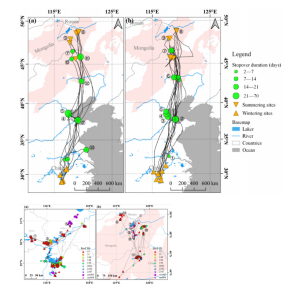Twenty Far East Greylag Geese, Anser anser rubrirostris, were captured and fitted with Global Positioning System/Global System for Mobile Communications (GPS/GSM) loggers to identify breeding and wintering areas, migration routes and stopover sites. Telemetry data for the first time showed linkages between their Yangtze River wintering areas, stopover sites in northeastern China, and breeding/molting grounds in eastern Mongolia and northeast China. 10 of the 20 tagged individuals provided sufficient data. They stopped on migration at the Yellow River Estuary, Beidagang Reservoir and Xar Moron River, confirming these areas as being important stopover sites for this population. The median spring migration duration was 33.7 days (individuals started migrating between 25 February and 16 March and completed migrating from 1 to 9 April) compared to 52.7 days in autumn (26 September–13 October until 4 November–11 December). The median stopover duration was 31.1 and 51.3 days and the median speed of travel was 62.6 and 47.9 km/day for spring and autumn migration, respectively. The significant differences between spring and autumn migration on the migration duration, the stopover duration and the migration speed confirmed that tagged adult Greylag Geese traveled faster in spring than autumn, supporting the hypothesis that they should be more time‐limited during spring migration.

